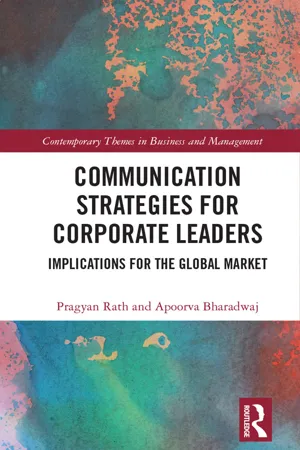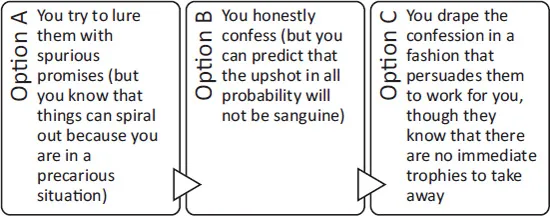
Communication Strategies for Corporate Leaders
Implications for the Global Market
- 268 pages
- English
- ePUB (mobile friendly)
- Available on iOS & Android
Communication Strategies for Corporate Leaders
Implications for the Global Market
About This Book
Communication is key to success in every aspect of life and ever so in a competitive business environment. This book examines managerial communication from seminal theoretical and demonstrative vantage points through interdisciplinary amalgamation of sciences and the liberal arts. It presents new paradigms of managerial communication in the form of manoeuvres that can act as game changers in tug-of-war business situations, including difficult negotiations, conflicts and interpersonal dissonance that characterise the day-to-day corporate workplace tenor.
This volume:
-
- Develops persuasion strategies based on argumentation tactics derived, for example, from legal cross-examination.
-
- Introduces 'problematisation' and 'deconstruction' as effective communication tools into mainstream managerial discourse.
-
- Employs Harvard Business School cases to demonstrate problem-solving skills, which will further serve as guide to writing business reports, plans and proposals.
-
- Positions business writing methods as taxonomical tenets that can help tackle complex business scenarios.
-
- Draws business diagnostic procedures from diverse fields such as Sherlock Holmes from popular culture, and Jared M. Diamond from ecology.
This book will be a significant resource for business communication practitioners, especially corporate managers and leaders, sales and marketing professionals, and policymakers. It will be of interest to teachers and students alike, in business communication, organization behaviour, human resource management and marketing communications. It will act as a useful aid for classroom efficacy for teachers and academics.
Frequently asked questions
Information
Chapter 1
Prelude to communication strategies for global corporate leaders
Readership
- Students can benefit from intensively worked out case studies from various managerial domains that relate to their career building endeavours.
- Communication instructors in management academia can benefit from the conceptual frameworks built and their detailed applications which can be used to make the process of teaching-learning more efficacious.
- Corporate professionals can use the communication manuals developed in the work for their daily transactions.
- Researchers can apply the theoretical contexts used in the work to develop new communication projects. As a majority of communication books (both Indian and international) have their content focus on formats and terminologies, this work intends to demonstrate how concepts have been evolved which rationally culminate into format designs, frameworks and terminologies that further add to the quintessential basis of managerial communications.
- Interdisciplinary scholars will find the work interesting since they would be able to comprehend how to use and apply their niche expertise in developing mainstream corporate communication literature.
- International students pursuing global careers can use this work to understand Indian markets and the application of interdisciplinary techniques of communication in the Indian as well as global contexts.
Methodology
Highlights
- It is positioned as the only book of its kind which delineates powerful communication strategies and their applications unlike many mainstream books on communication which either do not cover communication strategies at all, or just theorise on these strategies without presenting their applicability in corporate scenarios.
- This book presents new paradigms of persuasion in the form of manoeuvres that can act as game changers in tug-of-war business situations comprising difficult conversations like negotiations, conflicts and interpersonal dissonance that characterise day-to-day corporate workplace tenor. It equips communicators with argumentation skills that can retrieve a lost argument. For the first time, persuasion strategies have been “insourced” from argumentation tactics
- (a) used by lawyers to frame and position their wit to win a point (for instance, cross-examination);
- (b) used by Critical Discourse theorists to frame and position their new theoretical inputs (for instance, Judith Butler positioning Body Theory in feminist discourse and Derrida positioning Deconstruction in Poststructural discourse).
- The book breaks the stereotypical taxonomy of business messages which routinely use four categories – routine, good news, bad news and persuasive. The book brings a comprehensive string of business situations that call for strategic responses rather than staying with formatting protocols. We have elevated the process of writing messages from a formal routine etiquette or duty to a strategic tool for tackling critically intricate business scenarios. We have identified certain business situations not in regular circulation and used them to show how writing strategically becomes a powerful tool in the hands of the manager.
- It is the only book in the global market to take up case studies as one of its major learnings. Harvard business cases which are used worldwide in management institutes have been employed for the first time in a book on communications (both in India and outside) to demonstrate problem solving skills which also act as precursors to writing business reports, plans and proposals. As an addendum to this toolkit of solved Harvard cases, we also add some hypothetical but familiar domestic situations that call for critical thinking skills that contribute to intelligent configuration of business reports, plans and proposals. We deploy diagnostic procedures from medical sciences as well as taxonomical tenets from zoology and botany as guiding principles for scrutinising situations of corporate investigations. Sherlock Holmes and the evolutionary ecologist Jared M. Diamond have been invoked to give a new perspective to the investigative function of scrutinising not-so-obvious or camouflaged managerial problems to derive insightful problem statements and use them to present targeted solutions.
Preview: chapter snapshots
- Chapter 1: Prelude to communication strategies for global corporate leaders
- (a) how diverse audiences – students, teachers, researchers and corporate professionals, both Indian and international – can benefit from the book;
- (b) how the book is uniquely positioned as the only work of its kind imparting innovative concepts and frameworks with their pragmatic applications delivered.
- Chapter 2: Walk the talk: application of communication strategy
- Chapter 3: Checkmate: persuade to win
- Chapter 4: You’ve got mail: strategy in style
- Chapter 5: Sherlock Holmes in action: managerial investigations (cases, reports, proposals, plans)
- (a) domestication of problem through Anna Karenina Principle (evolutionary ecologist, Jared M. Diamond);
- (b) verification and falsification through medical patterns of diagnosis (medical practitioner and novelist, Sir Arthur Conan Doyle);
- (c) historicisation (New Historicism).
- (a) two Harvard Business cases analysed and presented in the form of corporate reports;
- (b) two indigenous business cases analysed and presented in the format of submission ready corporate reports; and
- (c) one business plan and one business proposal completely drafted based on a hypothetical new business offering pitched in for funding.
Stimulating the curious minds of diverse readers
Steeped in the dense theories of the erudite past
For contemporary managers in the world, furious and fast.
Chapter 2
Walk the talk
Application of communication strategy

Table of contents
- Cover
- Title
- Copyright
- Contents
- List of figures
- List of tables
- List of scripts
- Commentaries and explanations
- Case studies and caselets
- Acknowledgements
- 1 Prelude to communication strategies for global corporate leaders
- 2 Walk the talk: application of communication strategy
- 3 Checkmate: persuade to win
- 4 You’ve got mail: strategy in style
- 5 Sherlock Holmes in action: managerial investigations (cases, reports, proposals, plans)
- Appendix case 1: taking the cake
- Appendix case 2: the CEO’s private investigation
- Index